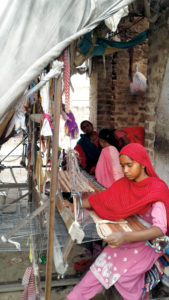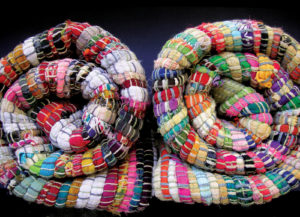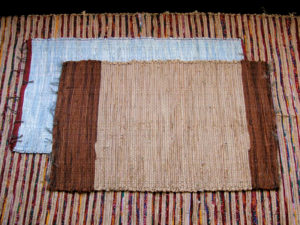
In India, the most common meaning for chindi is ‘torn cloth’; encountered either as a waste byproduct in the textile industry (post-industrial) or, more commonly, as the end-of-life residue of fabrics in use in households (post-consumer). For generations, this form of textile waste, torn strips of cloth, has been repurposed as colorful twine for tapestry or household craft projects, or hand-loom woven into floor mats and wall hangings from very small to very large.
This weaving activity is prevalent in rural communities, with the northern Indian states boasting multiple hand-loom weaving clusters. In rural areas, household waste is often consigned to a local weaver for a custom rug to be made with your waste, to your dimensions; the consignors can participate in the design elements and pattern layout as well, depending on their level of engagement. The woven product is a chindi rug, better known as a rag rug in western markets. This utilitarian rug, with a coarse look and feel, is intended to be quite cheap. Coincidentally, in local folklore, an alternate (derogatory) meaning of ‘chindi’ is ‘cheap’!
Domestic chindi waste is primarily soft cotton, available in a spectrum of bright colors. Waste fabric softness and the ability of the fabric strip width to curl up into a near circular cross-section is an essential prerequisite. The curled strips of near uniform width, with the free edges not readily visible, yield a tightly woven rug with a smooth finish.
A chindi rug made entirely of domestic waste is a bright, often garish cacophony of colors. Domestic consumption largely caters to the lower economic rungs, and few statistics on their use are available. In recent years, however, chindi rugs have become popular in export markets, and demand continues to increase steadily, helped by increasing manufacturing quality, sophistication and the muted color schemes now offered to satisfy export tastes.
Balancing trade
Chindi export volume dwarfs domestic use, and textile selvage waste is now routinely imported into India for the express purpose of hand-loom weaving and exporting rag rugs. India has essentially evolved as the manufacturing (job-work) base for chindi exports. This export-oriented hand-loom activity is supported by the Indian government to aid local communities of weavers; the government specifically liberalized the import of new trim cutting waste for use in chindi rugs by removing any controls on quantities imported, and later designated a special import category of chindi waste with preferential import duties and taxes.
To use a western cliché, a rag rug is the spam equivalent in textile products. Technically, any fabric waste can be inserted into a rag rug. To meet the demand growth in exports, cotton waste is increasingly supplemented with synthetic trim waste of poly-cotton, polyesters and nonwoven elements. Rugs are embellished with silk, taffeta and satin waste as well. The inclusion of synthetic waste is a welcome opportunity for western nations that are generators of large quantities of industrial fabric waste primarily in the synthetics category—it can now be effectively repurposed and diverted away from landfills in a sustainable manner.

According to the most recently available trade data (2014–2016), 10 million pounds of chindi trim waste was imported into India, and more than 24 million pounds of finished chindi rugs were exported. Import of chindi waste continues to scale with the gradual increase in chindi rug exports. The specific origin of the waste and the destination of the finished product is particularly interesting in terms of the import-export round trip.
One interesting imbalance is that the majority of chindi waste originates from Germany (57.6 percent by weight); the U.S. is a distant second, contributing only 22.1 percent of chindi source material waste. Yet the destination of most finished products is the United States. It’s likely that Germany is not the largest generator of such waste, but is simply more successful in exporting more of its trim waste to India.
At the export end, the United States is the largest consumer of these products (42.9 percent by weight and 52.7 percent by value). The weight-to-value disparity denotes that higher-quality product is exported to the United States. On that end, Germany falls to eighth position, accounting for only 2.5 percent of the export volume by weight. On a global aggregate, about $1.55/lb of value addition is created in India for this jobbing work, with the artisan receiving less than a third of that amount.
Rags, rugs and riches

Enkad Sciences, based in San Diego, Calif., currently exports and repurposes synthetic fabric selvage (such as RFL dip-coated chafer PET/PA and silicone-coated PA airbag trim waste) into chindi source material streams. The objective is to ramp up U.S. fabric trim waste exports to better align with the country’s dominant consumption of the finished products. As a jobbing destination, we found local weavers very receptive to our waste streams and willing to create products to our specifics. The trading market and exporters, however, have been unsure how these products will be received in foreign markets.
Historically, the chindi rug has been a custom-made product, using one’s own fabric waste. In this context, while the waste generator and the end consumers will be different, it is feasible that end products can be tailored or designed to incorporate larger quantities of U.S.-generated waste. This is likely to be a collective process between waste generators and importers in the U.S., where such closed-loop activities are actively pursued, rather than just passive and disparate import of finished products. The United States market is the single largest driver/consumer of this chindi product, providing a natural opportunity to influence its material makeup and design. Rakesh Agarwal, owner and president of Rugs & Home outlet stores in the Carolinas, has commented on the increasing popularity and diversification of chindi products. While traditionally a high value carpet outlet, Rugs & Home has incorporated chindi rugs in its outlet inventory of items. Rakesh and fellow importers are also driving innovation by creating additional and alternative products, such as bright chindi sofa cushions and pillows.
From Enkad’s initial selection of RFL dip-coated chafer PET/PA and silicone-coated PA airbag trim waste, the former (RFL chafer trim) is the more challenging waste stream: A single plant can generate more than 200,000 pounds of chafer waste annually, with limited disposal options of incineration or sending to landfills. As a chindi rag, however, the waste offers opportunities and cost advantages, although it is rather stiff, comes in limited shades of tan, and does not curl well. Airbag trim is soft and curls well, but is more expensive. Enkad Sciences has engaged directly with hand-loom clusters to manufacture rugs for domestic and export markets and is working to expand this industry, with help from generators of textile wastes and U.S. importers to drive acceptance and consumption of these U.S. waste-centric recycled products.
While this may be many Review readers’ first introduction to the word chindi, it appears across the continents. In Navajo Indian religious belief, a chindi is the ghost left behind after a person dies: the “residue that man has been unable to bring into universal harmony” (from The Natural History of the Soul in Ancient Mexico, 1997, Yale University Press). The selvage trim, residual waste as it may be in the western context, does have a functional afterlife in these chindi rugs.
Bimal Kad, Ph.D., is president and CEO of Enkad Sciences in San Diego, Calif.
 TEXTILES.ORG
TEXTILES.ORG


